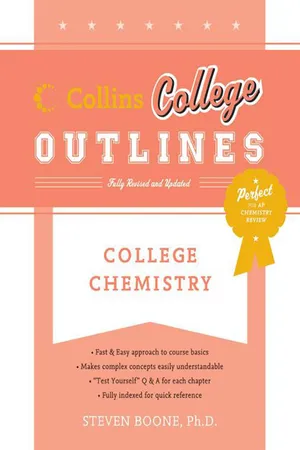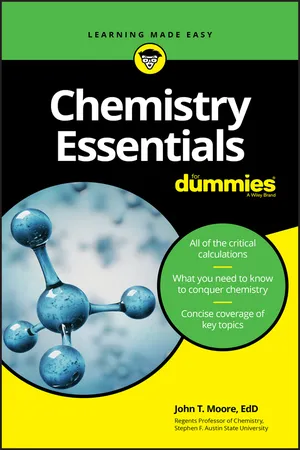Chemistry
Single and Double Replacement Reactions
Single and double replacement reactions are types of chemical reactions. In a single replacement reaction, one element replaces another in a compound. In a double replacement reaction, the positive and negative ions of two ionic compounds exchange places, forming two new compounds. These reactions are important in understanding chemical changes and are commonly studied in chemistry.
Written by Perlego with AI-assistance
Related key terms
Related key terms
1 of 4
Related key terms
1 of 3
4 Key excerpts on "Single and Double Replacement Reactions"
- Albert S. Tarendash(Author)
- 2021(Publication Date)
- Barrons Educational Services(Publisher)
2 → CO using smallest whole-number coefficients. (b) Then use the following particle diagrams to represent the balanced equation:Answers
- 2C + O2 → 2CO
-
Passage contains an image
3.5 CLASSIFYING CHEMICAL REACTIONS
As noted in Section 3.4, an equation describes a specific chemical reaction. Since there are so many chemical reactions, chemists find it useful to place them in various categories based on their similarities. Throughout this book, we will be examining these categories. We begin, in this section, with the four simplest types of chemical reactions.Direct Combination (Synthesis) Reactions
A direct combination (or synthesis) reaction involves the combination of two or more reactants to produce one product. The reactants can be elements or compounds. In general, we can write a direct combination reaction in the formAs an example, the production of iron(II) chloride from iron and chlorine is a direct combination reaction:Another example involves the production of carbon dioxide from the combination of carbon monoxide and oxygen:Try It Yourself
Write a balanced equation for the direct combination of sodium(s) and bromine(ℓ) to produce a solid product.Answer
Decomposition Reactions
A decomposition reaction involves the breakdown of a single reactant into two or more products. It is the opposite of a direct combination reaction. In general, we can write a decomposition reaction in the formAs an example, hydrogen peroxide decomposes into water and oxygen:Try It Yourself
Write a balanced equation for the decomposition of ammonia gas (NH3 ) into its elements.Answer
2NH3 (g) → N2 (g) + 3H2 (g)Single-Replacement Reactions
In a single-replacement reaction, an uncombined element replaces another element that is part of a compound. As a result, the replaced element becomes uncombined. In general, we can write a single-replacement reaction in the formAs an example, the element zinc replaces the element copper from an aqueous solution of the compound copper(II) sulfate:Single-replacement reactions occur only under certain conditions. For example, the replacement of zinc by copper (the reverse of the reaction shown above) will not occur. Since zinc replaces copper from solution, zinc is said to be a more active metal than copper. In other words, zinc will form a positive- No longer available |Learn more
- Steven Boone, Drew H. Wolfe(Authors)
- 2011(Publication Date)
- Collins Reference(Publisher)
CHAPTER 5Introduction to Chemical Reactions
I n this chapter, we begin our study of inorganic chemical reactions and solution stoichiometry. The first section introduces the general types of inorganic reactions. The second section covers precipitation reactions—those in which a solid insoluble substance forms. In the final two sections, acid-base and oxidation-reduction reactions are considered.5.1 INORGANIC REACTIONSDetermining patterns in chemical reactions will permit prediction of the reaction products. Classification of Inorganic Reactions Inorganic reactions may be subdivided into four major types.Combination reaction in which two substances combine: A + X → AX. Decomposition reaction; the reverse of a combination reaction: AX → A + X. Single replacement reaction in which an element replaces another element that is part of a compound: A + BX → AX + B. Metathesis or double replacement in which elements in different compounds replace each other: AX + BY → AY + BX.Combination Reactions (A + X → AX)A combination reaction occurs when two substances join and form a compound. The general equation for all combination reactions is:A + X → AXin which A and X are either elements or compounds and AX is a compound. Some common types of combination reactions include metal oxide formation. A metal oxide forms when a metal undergoes a combination reaction with a nonmetal. For example, when calcium, Ca(s), reacts with oxygen gas, O2 (g), solid calcium oxide, CaO(s), results.2Ca(s) + O2 (g) → 2CaO(s)Another example is base formation combination reaction. Metal oxides undergo a combination reaction with water to produce bases. A base is a compound that increases the OH- (aq) ion concentration in aqueous solutions. For example, the base sodium hydroxide, NaOH, forms from sodium oxide, Na2 O(s), and H2 O(1).Na2 O(s) + H2 O(1) → 2NaOH(aq)A final example of a combination reaction is acid formation combination reaction. An acid forms from the combination reaction of a nonmetal oxide and water. An acid is a compound that increases the H+ (aq) ion concentration in aqueous solutions. For example, sulfuric acid, H2 SO4 , results when gaseous sulfur trioxide, SO3 - Mark Kernion, Joseph A. Mascetta(Authors)
- 2021(Publication Date)
- Barrons Educational Services(Publisher)
PART VCHEMICAL REACTIONS
Passage contains an image
8 CHEMICAL REACTIONS AND THERMOCHEMISTRY
WHAT YOU WILL LEARN
Upon completing this chapter, you will be able to:•Identify the driving force for these four major types of chemical reactions and write balanced equations for each: combination (or synthesis), decomposition (or analysis), single replacement, and double replacement•Explain hydrolysis using a balanced equation •Identify and explain graphically enthalpy changes in exothermic and endothermic reactions •Use Hess’s Law to show the additivity of heats of reactions •Calculate enthalpy from bond energies
The many kinds of reactions you may encounter can be placed in four basic categories: combination, decomposition, single replacement, and double replacement.Types of ReactionsThe first type, combination, can also be called synthesis. This means the formation of a compound from the union of its elements. Some examples of this type areThe second type of reaction, decomposition, can also be referred to as analysis. This means the breakdown of a compound to release its components as individual elements or other compounds. Some examples of this type areThe third type of reaction is called single replacement or single displacement. This type can best be shown by examples in which one substance is displacing another. Some examples areThe last type of reaction is called double replacement or double displacement because there is an actual exchange of “partners” to form new compounds. Some examples of this arePredicting ReactionsOne of the most important topics of chemistry deals with the reasons why reactions take place. Taking each of the above types of reactions, let us see how a prediction can be made concerning how the reaction gets the driving force to make it occur.COMBINATION (SYNTHESIS)The best source of information in predicting a chemical combination is the heat of formation table. A heat of formation table gives the number of calories evolved or absorbed when a mole (gram-formula mass) of the compound in question is formed by the direct union of its elements. In this book, a positive number indicates that heat is absorbed, and a negative number that heat is evolved. It makes some difference whether the compounds formed are in the solid, liquid, or gaseous state. Unless otherwise indicated (g = gas, ℓ = liquid), the compounds are in the solid state. The values given are in kilojoules; 4.18 joules is the amount of heat needed to raise the temperature of 1 g of water one degree on the Kelvin scale. The symbol ΔH- eBook - ePub
- John T. Moore(Author)
- 2019(Publication Date)
- For Dummies(Publisher)
This double-displacement reaction, called a neutralization reaction, forms water. Take a look at the mixing solutions of sulfuric acid (auto battery acid,) and sodium hydroxide (lye, NaOH). Here are the molecular, ionic, and net-ionic equations for this reaction: To go from the ionic equation to the net-ionic equation, you let the spectator ions (those that don’t really react and that appear in an unchanged form on both sides on the arrow) drop out. Then reduce the coefficients in front of the reactants and products down to the lowest common denominator. Combustion reactions: Burning Combustion reactions occur when a compound, usually one containing carbon, combines with the oxygen gas in the air. This process is commonly called burning. Heat is the most useful product of most combustion reactions. Here’s the equation that represents the burning of propane: Combustion reactions are also a type of redox reaction. Redox reactions: Exchanging electrons Redox reactions, or reduction-oxidation reactions, are reactions in which electrons are exchanged. The following three reactions are examples of other types of reactions (such as combination, combustion, and single-replacement reactions), but they’re also all redox reactions — they all involve the transfer of electrons from one chemical species to another: Redox reactions are involved in combustion, rusting, photosynthesis, respiration, the movement of electrons in batteries, and more. I talk about redox reactions in some detail in Chapter 8. Balancing Chemical Equations If you carry out a chemical reaction and carefully sum up the masses of all the reactants, and then you compare the sum to the sum of the masses of all the products, you see that they’re the same. In fact, a law in chemistry, the law of conservation of mass, states, “In an ordinary chemical reaction, matter is neither created nor destroyed.” This means that you neither gain nor lose any atoms during the reaction
Index pages curate the most relevant extracts from our library of academic textbooks. They’ve been created using an in-house natural language model (NLM), each adding context and meaning to key research topics.
Explore more topic indexes
Explore more topic indexes
1 of 6
Explore more topic indexes
1 of 4



